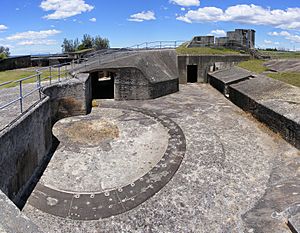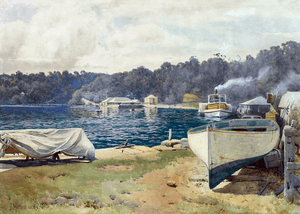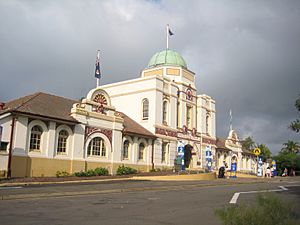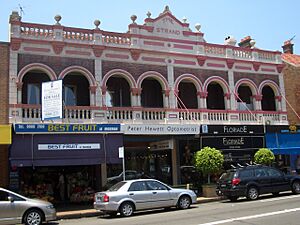Mosman, New South Wales facts for kids
Quick facts for kids MosmanSydney, New South Wales |
|||||||||||||||
|---|---|---|---|---|---|---|---|---|---|---|---|---|---|---|---|
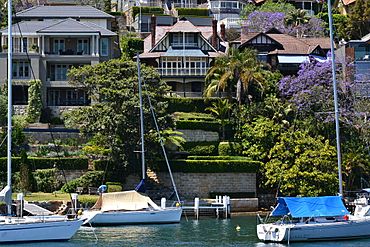
View of Mosman from the Mosman ferry
|
|||||||||||||||
| Population | 28,475 (2016 census) | ||||||||||||||
| • Density | 3,273/km2 (8,480/sq mi) | ||||||||||||||
| Postcode(s) | 2088 | ||||||||||||||
| Elevation | 79 m (259 ft) | ||||||||||||||
| Area | 8.7 km2 (3.4 sq mi) | ||||||||||||||
| Location | 8 km (5 mi) NE of Sydney CBD | ||||||||||||||
| LGA(s) | Mosman Council | ||||||||||||||
| State electorate(s) | North Shore | ||||||||||||||
| Federal Division(s) | Warringah | ||||||||||||||
|
|||||||||||||||
Mosman is a cool suburb located on Sydney's Lower North Shore in New South Wales, Australia. It's about 8 kilometers (5 miles) north-east of the main city center of Sydney. Mosman is also where the local government for the area, the Municipality of Mosman, is based.
Contents
Exploring Mosman's Neighborhoods
Even though Mosman is the main suburb, people can still use some older, traditional names for different parts of the area if they want to. These are like smaller neighborhoods within Mosman.
Mosman's Past: A Look Back
Mosman is named after Archibald Mosman (1799–1863) and his twin brother George. They moved to the area in 1831 and started a whaling station. This station was on a bay in the harbor, which became known as Mosman’s Bay. Archibald continued with whaling, and by 1838, he owned a large area along the Mosman waterfront.
Aboriginal History and Culture
The Borogegal tribe originally lived in the Mosman area. A famous Aboriginal leader named Bungaree (around 1775–1830) was from this tribe. He joined British explorers on voyages, even sailing around Australia with Matthew Flinders. Later, he became a tribal leader and was given land at Georges Head. He was known for greeting new ships entering Port Jackson and became friends with explorers from Russia and France. Many paintings of him were made and shown in cities like London and Paris.
European Settlement and Early Days
In 1789, the ship HMS Sirius, which was the main ship of the First Fleet, entered what is now Mosman Bay. Since 1801, Mosman has been an important place for maritime and defense activities in Sydney. Forts like Middle Head Fort, Georges Head Battery, and Bradleys Head Fortification Complex were built here to protect Sydney Harbour. In 1871, the Beehive Casemate, a special gun placement, was built into the cliff at Obelisk Bay.
A special depot for "Submarine Miners" was built at Chowder Bay (Georges Head) in the 1880s. These miners were trained to lay and explode underwater mines to protect the harbor. From 1876 to 1922, minefields were placed across the main shipping channels of Port Jackson. The miners at Georges Head would watch for enemy ships. Their job was to explode the mine closest to an approaching enemy ship. Sadly, in 1891, a demonstration of these mines led to a fatal accident, killing four miners.
In the 1880s and 1890s, many artists came to Mosman. They were inspired by the "en plein air" (outdoor painting) style from France. These artists created special art communities, making Mosman known as "Australia's most painted suburb." Famous painters like Julian Ashton, Tom Roberts, and Arthur Streeton lived and worked here.
During the Second World War in 1942, a large anti-submarine net was built at Georges Head. This net was designed to stop enemy submarines from entering Sydney Harbour. On May 31, 1942, three Japanese mini-submarines tried to enter the harbor. One of them got caught in the net, and the crew blew up their submarine.
Chowder Bay was used in the late 1820s by American whaling ships. In 1831, Archibald Mosman and John Bell started a whaling station in Mosman Bay. The only building left from that time is The Barn on Avenue Road. It was a store and sail drying house, and today it's home to the 1st Mosman 1908 Scout Group.
A walking track connected North Sydney to Middle Head in the 1840s. Roads like Avenue Road, Military Road, and Middle Head Road were built later, making it easier to get around. In the 1870s, more people started settling in Mosman, especially with the start of regular ferry services. Richard Harnett Senior bought Archibald Mosman’s land in 1859 and started a quarry. He also helped start a ferry service between Mosman Bay and Circular Quay.
His son, Richard Harnett Junior, became the first Mayor when Mosman became its own municipality in 1893. Both men were very important in developing Mosman, building roads and improving transport. Mosman Public School opened in 1880.
Around the early 1900s, many shops and beautiful Federation architecture homes were built. Taronga Zoo opened in 1916, moving from an older site. "Taronga" is an Aboriginal word meaning 'beautiful view'. Later, in the 1950s, more apartment buildings started to appear, which led to new rules about building sizes.
Cool Places to Visit in Mosman
Mosman is a peninsula, meaning it's surrounded by water on three sides, between Sydney Harbour and Middle Harbour. It has many lovely harbor beaches, like Balmoral, Chinamans Beach, and even two beaches where clothing is optional: Obelisk Beach and Cobblers Beach.
Other fun places include Taronga Zoo, Bradleys Head, and parts of Sydney Harbour National Park. In Rawson Park, you can see the Scotland Australia Cairn, a memorial made of stones from every part of Scotland. It celebrates Scottish pioneers in Australia. Highland games are often held there.
On the eastern side of Sirius Cove is where Curlew Camp used to be. This was a famous spot where artists like Arthur Streeton and Tom Roberts lived and painted. The council has even created a special walk called the Curlew Camp Artists Walk. Ashton Park is another popular spot, with Athol Hall offering a café and event space.
Historic Buildings and Landmarks
Mosman has many buildings and places that are important to its history. Here are a few:
- The Barn, Scout Hall (3a Avenue Road): This is the oldest building from the original whaling station.
- Alma House (114 Belmont Road)
- Bradleys Head Fortification Complex (within Sydney Harbour NP): These are old forts built to protect the harbor.
- Woolley House (34 Bullecourt Avenue)
- 42 Cowles Road
- 28 Mistral Avenue
- Igloo House (65 Parriwi Road)
- Mosman's first big home, 'The Nest', was built in 1833.
- Oswald Bloxsome built 'The Rangers' in 1844, a large mansion overlooking Mosman Bay.
- Boronia House, built in 1885, has been used for many things, including the local library.
- Monterey, built in 1905, is a grand three-story building above Mosman Bay. It was once a boarding house and is now divided into fancy units.
- The Manor, built around 1911 near Clifton Gardens, is a large mansion. It became an important center for the Theosophical Society and is still used by them today.
- Avenue Cottage, built in 1886, is a small sandstone cottage on Avenue Road.
-
Boronia House, built in 1885
Shopping and Eating
Mosman's main shopping area is along Military Road. You'll find many unique shops, cafes, and restaurants there. This shopping strip is considered a special historical area. A small shopping mall called Bridgepoint is located at Spit Junction.
Education in Mosman
Mosman has many great schools for students of all ages:
- Mosman High School
- Mosman Public School (opened in 1880)
- Beauty Point Public School
- Middle Harbour Public School
- Sacred Heart Catholic Primary School
- Blessed Sacrament Catholic Primary School
- Mosman Church of England Preparatory School (Mosman Prep)
- Queenwood School for Girls (with four campuses)
- Mosman Community College (MCC)
Places of Worship
Mosman has several churches for different faiths:
- C3 Mosman Church
- Sacred Heart Roman Catholic Church
- Blessed Sacrament Roman Catholic Church
- St Clement's Anglican Church
- St Luke's Anglican Church
- Mosman Uniting Church
- Mosman Baptist Church
- Scots Kirk Presbyterian Church
- Sydney Life Church
- Mosman Malayalam Church
Sports and Fun Activities
Mosman has many sports clubs for the community:
- Mosman Swans Junior AFL Club
- Mosman Football Club
- Mosman Rugby Club
- Mosman Cricket Club
- Mosman Rowing Club
- Mosman Hockey Club
Famous Australian cricket captains Allan Border and Ian Craig grew up in Mosman and played for the local club.
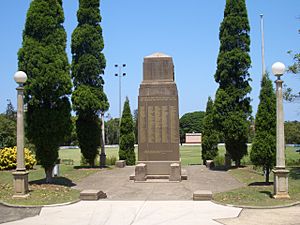
Culture and Arts
- Bard on the Beach (formerly Shakespeare by the Sea) is a fun outdoor event held at Balmoral Beach in the summer.
- The Mosman Art Prize is an art competition held every year.
- Nancy Phelan's book, A Kingdom by the Sea (1969), shares vivid memories of Mosman around 1920.
See also
 In Spanish: Mosman para niños
In Spanish: Mosman para niños



